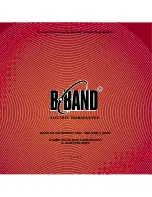
Page 36 of 90
CCT24
Trace Separation from
50 ohm Microstrip
Length of Trace Run
Parallel to Microstrip
100 mil
125 mill
150 mil
200 mil
200 mil
290 mil
250 mil
450 mil
300 mil
650 mil
Table 3.3.2
connector and the antenna or antenna connector on the host circuit board should be implemented as a
50 ohm stripline. Referring to Figure 3.3.1, the width of this stripline depends on the thickness of the
circuit board between the stripline and the groundplane. For FR-4 type circuit board materials (dielectric
constant of 4.7), the width of the stripline is equal to 1.75 times the thickness of the circuit board. Note
that other circuit board traces should be spaced away from the stripline to prevent signal coupling, as
shown in Table 3.3.2. The stripline trace should be kept short to minimize its insertion loss.
3.4 Input Voltages
CCT24 radio modules can operated from an unregulated DC input (Pad 19) in the range of 3.3 to 5.5 V
with a maximum ripple of 5% over the temperature range of -40 to 85
o
C.
Applying AC, reverse DC, or a
DC voltage outside the range given above can cause damage and/or create a fire and safety hazard.
Further, care must be taken so logic inputs applied to the radio stay within the voltage range of 0 to 3.3 V.
Signals applied to the analog inputs must be in the range of 0 to ADC_REF (Pad/Pin 3). Applying a
voltage to a logic or analog input outside of its operating range can damage the CCT24 module.
3.5 ESD and Transient Protection
The CCT24 circuit boards are electrostatic discharge (ESD) sensitive. ESD precautions must be observed
when handling and installing these components. Installations must be protected from electrical transients
on the power supply and I/O lines. This is especially important in outdoor installations, and/or where
connections are made to sensors with long leads.
Inadequate transient protection can result in damage
and/or create a fire and safety hazard.
3.6 Interfacing to 5 V Logic Systems
All logic signals including the serial ports on the CCT24 are 3.3 V signals. To interface to 5 V signals, the
resistor divider network shown in Figure 3.5.1 below must be placed between the 5 V signal outputs and
the CCT24 signal inputs. The output voltage swing of the CCT24 3.3 V signals is sufficient to drive 5 V
logic inputs.
Figure 3.6.1
CCT24
















































